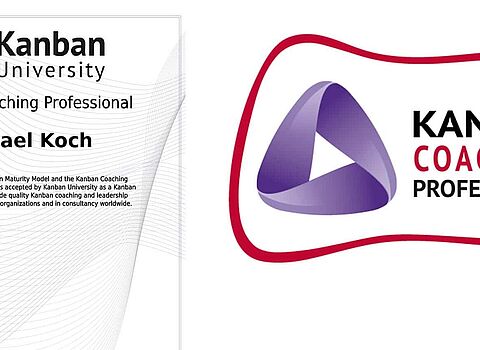Agile working is particularly about increasing employee-team responsibility for the individual - introducing less control from above - and thus allowing company employees to act flexibly, quickly and with maximum customer orientation. Structures with fewer hierarchies and increased team motivation are to be created, and this in turn results (at best) in an increased desire to learn and a general openness to feedback as well as a correspondingly open corporate culture. Through such an agile mindset, companies can ensure employee satisfaction on the one hand. On the other hand, these companies will virtually automatically push their customer satisfaction, achieve increased customer loyalty and ultimately expand their competitiveness.
What effects do agile working methods produce?
Agile working can be seen as an answer to the constantly increasing speed with which projects as well as standard daily tasks have to be processed today. Furthermore, it actively accepts the realization that in many work processes deviations from the plan are the rule rather than an exception. Consequently, the creation of increased reaction speeds and flexibility are two of the central concerns of agile working methods. Under iterative procedures, it is important to regularly reflect and check whether the company or the team and its individual team members are still on the right course. If this is not the case, it is possible to react spontaneously and without long consultations upwards - just agile - and to adjust the direction. Less time is invested - or rather wasted - in meticulous planning, which in practice cannot be adhered to anyway. Instead, employees remain alert, curious, and focus less on predefined goals than on the best outcome that absolutely meets their needs. Accepting change is - or becomes - a natural part of the process. Overall, there is an elevation of employee ownership.
Furthermore, agility in the company puts the customer and his needs in the center. A procedure that is as close to the customer as possible, with continuous consultation, joint reflection and the implementation of the resulting adaptation requirements, is elementary. In the course of projects there are always - sometimes even several - changes in terms of customer opinions or requirements. Such circumstances can be accepted and implemented particularly efficiently by an agile company precisely because of the increased reaction speeds and flexibility of the employees described above. This in turn leads to the fact thatcustomers tend to feel more understood and are much more likely to receive results that fully meet their expectations. Customer satisfaction is therefore high in agile companies, resulting in increased customer loyalty and ultimately also better competitiveness.
Prerequisites for agile working and corresponding business success
The primary prerequisite for being able to establish agility in one's own company is the adoption of applicable mindsets at all levels. It is by no means enough to mandate agile methods at the top - for successful implementation, the entire company, from production to sales to the boardroom, must adopt an agile mindset. Classically managed companies often get off to a very successful start by first focusing on the development of leadership skills: respectful interaction with employees, an open ear at all times, appreciation and a good work-life balance are some of the first factors on the path to an agile organization and, above all, to employee satisfaction.
Furthermore, agile working methods require the possibility/willingness to learn - and promote this at the same time. Because only with a corresponding openness to knowledge absorption and development among people, teams and in the entire company can agility be implemented holistically. In this context, the "why" should also be clear. It is not just a matter of adopting agile in teams because other companies in the industry may be doing it. Rather, it must be made clear at all levels what is to be achieved under this approach. This makes the agile mindset more tangible and easier to accept for company employees. A very important prerequisite for agile working - which of course already goes hand in hand to a certain extent with the willingness to learn - is the will to change. Classically managed companies must inevitably undergo fundamental change in order to establish agile working methods. Under these circumstances, employees should have the broadest possible decision-making authority. Without such scope for decision-making, no change in the sense of agility can occur.
Methods of agile working
In 2001, Kent Beck and other software developers published the so-called Agile Manifesto. Based on their extensive experience in the execution of software projects, they formulated various ideas, principles and values that should lead to a more efficient approach in the execution of corresponding processes. Among other things, a new prioritization of values was made and thus the foundation for modern agile working methods was created. The following aspects are central to this:
- It is important to focus more on individuals and their interactions when completing tasks than on the process and the associated tools.
- A functioning product is more important than comprehensive documentation.
- Collaboration with customers plays a bigger role than contract negotiations.
- It is more desirable to be flexible, fast, and customer-focused to push customer satisfaction or increased customer loyalty than to follow a plan precisely.
Among these principles, various techniques have gradually emerged to put into practice the undoubtedly quite abstract principles and values of the manifesto. The use of an agile method has the effect of giving work processes a viable basic agile structure. However, they are not to be regarded as a strict set of rules. In order to be able to apply them to one's own work or project needs, they must be understood precisely. Only in this way can maximum success be achieved in terms of employee satisfaction, customer satisfaction, increased customer loyalty, competitiveness, etc.
De facto, however, not all agile working methods from software development - where in fact most approaches are still used - can be transferred to other business areas without further ado. Scrum is an exception. This method of agile working is therefore examined in more detail below.
KANBAN as an agile working method
The use of a KANBAN method is possible in many different areas of the company. The KANBAN work method is based on the pull principle, where the KANBAN board has absolute transparency of the individual work statuses and corresponding requirements to the team members as well as the customers and is operated in an agile manner.
What are the central advantages of the introduction of KANBAN in the company?
- constant improvement of the service for customers is in the foreground
- high transparency of current projects
- flexible ability to act
- shorter work processes
- permanent further development and adaptation of the system
- effective solutions
- fast, target-oriented results
- problem-free introduction for companies










